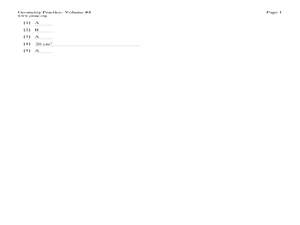Curated OER
Systems and Applications
In this algebra worksheet, 11th graders solve 14 systems of equations using substitution or elimination and 14 word problems.
Pennsylvania Department of Education
Length and Perimeter
Third graders explore tessellations and the spatial concepts used in creating them. For this tessellations lesson, 3rd graders rotate, reflect and transform shapes to create tessellations. Students become familiar with the vocabulary...
Curated OER
Applied Maxim Mininmum Problems
Students define the maximum and minimum of an equation. In this calculus lesson, students analyze point on a graph and determine when a graph is approaching a maximum or minimum. They take a Quiz after working some review problems.
Curated OER
Geometry in the Real World
Eighth graders complete a unit of lessons on basic geometry concepts. They participate in a variety of activities, culminating in a project that involves publishing a booklet or a poster that presents the major geometry concepts from the...
Curated OER
Building a Box
Young scholars create different two dimensional nets that can be folded to create a cube. In this visual spacial awareness lesson, students explore different ways that two-dimensional objects can be laid out to create a three dimensional...
Curated OER
House Dimensions
Fourth graders measure the perimeters of several different rooms. They convert the measurements using ratios that allow them to draw the rooms to scale on paper. They draw the dimensions of a house to scale. They measure length to the...
Curated OER
Pi Day (March 14)
Fourth graders determine the value of ? by measuring the circumference and diameter of circular objects such as soup cans, Oreo cookies, etc..
Curated OER
Five Volume of Pyramids Problems
In this pyramids worksheet, students calculate the volume of pyramids in four multiple choice and one free-response problem. The solutions are provided.
Curated OER
Interactions Among Living Things
Students role play predators and prey, classify organisms as predator or prey, and describe factors that affect population growth and size.
Curated OER
Play Dough Day
Twelfth graders build a model of the following figures with the base from column I and the cross-section from column II. Draw the base with labeled axes on the graph paper and construct the figure on top of the base with the play dough...
Curated OER
Volume of a regular pyramid
In this geometry worksheet, 10th graders apply the properties of a regular pyramid to determine the volume. The one page worksheet contains two free response questions. Answers are included.
Curated OER
Measure Me!
Third graders use nonstandard concrete methods to estimate and record measurements of their body.
Curated OER
Construct Figures to Find Specific Volume
Sixth graders use number cubes to explore volume of two-dimensional shapes. They roll a die and construct a shape using the numbers rolled as measurements of the sides. They estimate the volume of a given object, and then use the...
Curated OER
Keeps on Pumping
Pupils measure and calculate heart rates per minute and for other units of time. They determine the amount of blood pumped by their heart during various intervals of time.
Curated OER
Particulate Matter: How Dirty is the Air We Breathe?
Fourth graders work together to collect air samples for testing. They determine the amount of pollution in the air in their community. They discuss their results to end the lesson.
Curated OER
Class Penny Quilt
Students explore penny quilts made in the late 1700s through the early 1800s. They identify significant events from their lives and create their own class penny quilt displaying this information.

















